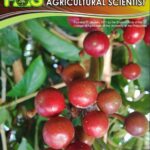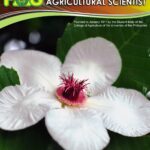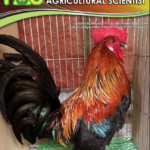Vol. 103, No. 4 (Dec 2020)
One of the most popular studies of coffee is in its aroma, together with its fatty acid content. The aroma of the coffee is composed of so many volatile compounds (Mondello, 2005). In this paper, the composition of volatile compounds of different varieties of coffee were analyzed using Headspace-Gas Chromatography-Mass Spectrometry. Data comparisons were made to determine the differences in the aroma profiles of each sample based on variety and roasting degree.
Categories
Articles
Overexpression of Maize (Zea mays L.) Malate Dehydrogenase (ZmMDH) in IR64 Rice (Oryza sativa L.) Leads to Altered Carbohydrate Metabolism as Revealed by Transcriptomics and Metabolite Analysis
Emmanuel T. Galang, Charisse Leanne B. Legaspi, Hsiang-Chun Lin, William Paul G. Quick, Neilyn O. Villa, and Ivan Marcelo A. Duka
Malate dehydrogenase (MDH) (EC 1.1.1.40) is among the major genes identified by the C4 Rice Consortium to play an important part in inducing C4 photosynthesis in a C3 rice system. Despite the vast information on the biochemical characteristics of the enzyme, the effects of engineering maize (Zea mays L.) MDH on IR64 rice (Oryza sativa L.) for the induction of the C4 pathway was never thoroughly studied in the light of transcriptomics. Two transformed IR64 rice events conferring overexpression of maize MDH (ZmMDH), namely MDH22 and MDH48, were analyzed using transcriptome analyses to assess differential expression of endogenous genes due to MDH overexpression. Sugar metabolite quantificati...
Malate dehydrogenase (MDH) (EC 1.1.1.40) is among the major genes identified by the C4 Rice Consortium to play an important part in inducing C4 photosynthesis in a C3 rice system. Despite the vast information on the biochemical characteristics of the enzyme, the effects of engineering maize (Zea mays L.) MDH on IR64 rice (Oryza sativa L.) for the induction of the C4 pathway was never thoroughly studied in the light of transcriptomics. Two transformed IR64 rice events conferring overexpression...
Phytochemical Properties, Antioxidant Activities, and Cytotoxicity of Ethanolic Bran Extracts from Philippine Pigmented Rice Cultivars
Rodel M. Bulatao, John Paulo A. Samin, Rochelle C. Huliganga, Reniel P. Tubera, Mark Aldren M. Feliciano, and Cesar V. Ortinero
Antioxidants are widely recognized for their immune-enhancing and disease-preventing properties. However, there are some reports that certain synthetic antioxidants can pose carcinogenic effects on human cells. Therefore, it is vital to look for an alternative source of natural, effective, and safe antioxidants for human consumption. In this study, ethanolic extracts of six pigmented rice bran samples were evaluated for their phytochemical properties, antioxidant activities, and cytotoxicity against normal human blood lymphocytes (NHBL). Results showed that the pigmented rice bran extracts had high total phenolic (70.1 – 178.4 mg.g-1 gallic acid equivalent), flavonoid (123.3 – 378.0 mg.g-...
Antioxidants are widely recognized for their immune-enhancing and disease-preventing properties. However, there are some reports that certain synthetic antioxidants can pose carcinogenic effects on human cells. Therefore, it is vital to look for an alternative source of natural, effective, and safe antioxidants for human consumption. In this study, ethanolic extracts of six pigmented rice bran samples were evaluated for their phytochemical properties, antioxidant activities, and cytotoxicity ...
Morpho-Anatomical Investigation on the Adventitious Rooting of Hard-to-Root Excelsa Coffee (Coffea excelsa A. Chev.) Stem Cuttings
Jeff M. Opeña, Rachel C. Sotto, Bong M. Salazar, and Calixto M. Protacio
Excelsa coffee (Coffea excelsa A. Chev.) species is known to be hard-to-root when propagated through stem cuttings. This study sought to examine the morpho-anatomical differences between Excelsa and Robusta coffee stem cuttings in order to identify any physical hindrances to rooting and to trace the origin of adventitious rooting in Excelsa coffee. Rooting of single-node orthotropic Excelsa coffee stem cuttings from water sprouts with and without incisions in the rooting zone applied with auxin plus ferulic acid takes 5 and 7 mo under mist, respectively. Morpho-anatomical examinations revealed that Excelsa coffee had thicker stem structures compared to Robusta coffee. However, the most pr...
Excelsa coffee (Coffea excelsa A. Chev.) species is known to be hard-to-root when propagated through stem cuttings. This study sought to examine the morpho-anatomical differences between Excelsa and Robusta coffee stem cuttings in order to identify any physical hindrances to rooting and to trace the origin of adventitious rooting in Excelsa coffee. Rooting of single-node orthotropic Excelsa coffee stem cuttings from water sprouts with and without incisions in the rooting zone applied with aux...
Genetic Analyses of Abaca (Musa textilis Née) Germplasm from its Primary Center of Origin, the Philippines, Using Simple Sequence Repeat (SSR) Markers
Orlex B. Yllano, Ma. Genaleen Q. Diaz, Antonio G. Lalusin, Antonio C. Laurena, and Evelyn Mae Tecson-Mendoza
This study presents the first extensive genetic diversity assessment of abaca (Musa textilis Née) germplasm in the Philippines using simple sequence repeat (SSR) markers. Southeast Asia is the recognized center of origin of the genus Musa, and the Philippines has the greatest number of abaca cultivars and wild genotypes in the world. In this study, a total of 150 accessions of abaca from Luzon, Visayas, and Mindanao, Philippines and two banana cultivars were analyzed using SSRs to examine their genetic diversity and similarity relationships. Six of 44 banana-based SSR primers were highly polymorphic, detecting 28 alleles with a mean of 4.55 alleles per locus and polymorphism information c...
This study presents the first extensive genetic diversity assessment of abaca (Musa textilis Née) germplasm in the Philippines using simple sequence repeat (SSR) markers. Southeast Asia is the recognized center of origin of the genus Musa, and the Philippines has the greatest number of abaca cultivars and wild genotypes in the world. In this study, a total of 150 accessions of abaca from Luzon, Visayas, and Mindanao, Philippines and two banana cultivars were analyzed using SSRs to examine the...
Honey or Pineapple Juice as Extender Components for Quezon Native and Duroc Boar Semen at Different Storage Temperatures
Christian H. Castro, Geleo A. Dichoso, Marysol M. Landicho, and Percival P. Sangel
Computer-assisted semen analyzer (CASA) was used to assess the effectiveness of formulated boar semen extenders supplemented with honey and/or pineapple juice. Four boars (i.e., Duroc = 2 and Quezon = 2) served as semen donors, where four ejaculates from each animal were used in this study. Only samples that passed the preliminary quality evaluation were further analyzed and processed. Semen samples were divided and randomly assigned into one of the 11 treatment groups: (T1) a medium-term commercial extender with antibiotics as positive control, (T2) prepared base extender without sugar and antibiotics as negative control (NC), (T3) NC + 0.5% honey, (T4) NC + 1% honey, (T5) NC + 2% honey,...
Computer-assisted semen analyzer (CASA) was used to assess the effectiveness of formulated boar semen extenders supplemented with honey and/or pineapple juice. Four boars (i.e., Duroc = 2 and Quezon = 2) served as semen donors, where four ejaculates from each animal were used in this study. Only samples that passed the preliminary quality evaluation were further analyzed and processed. Semen samples were divided and randomly assigned into one of the 11 treatment groups: (T1) a medium-term com...


